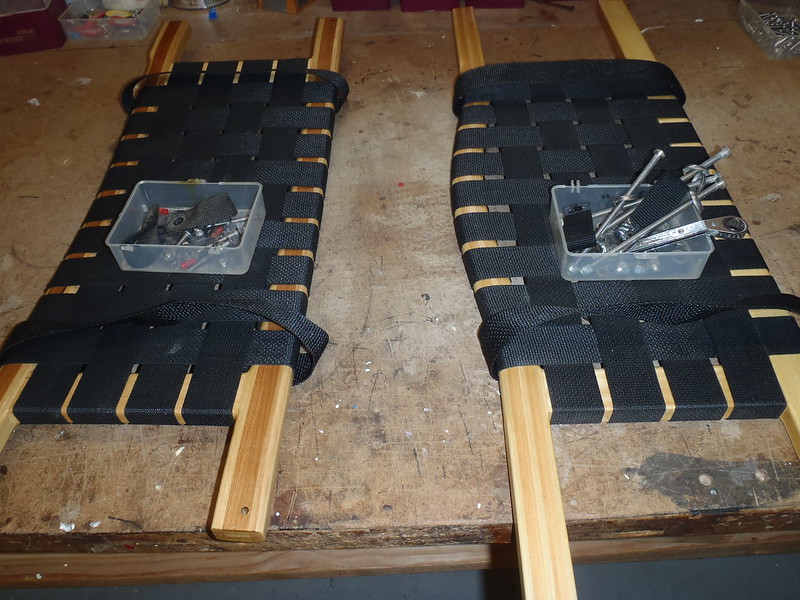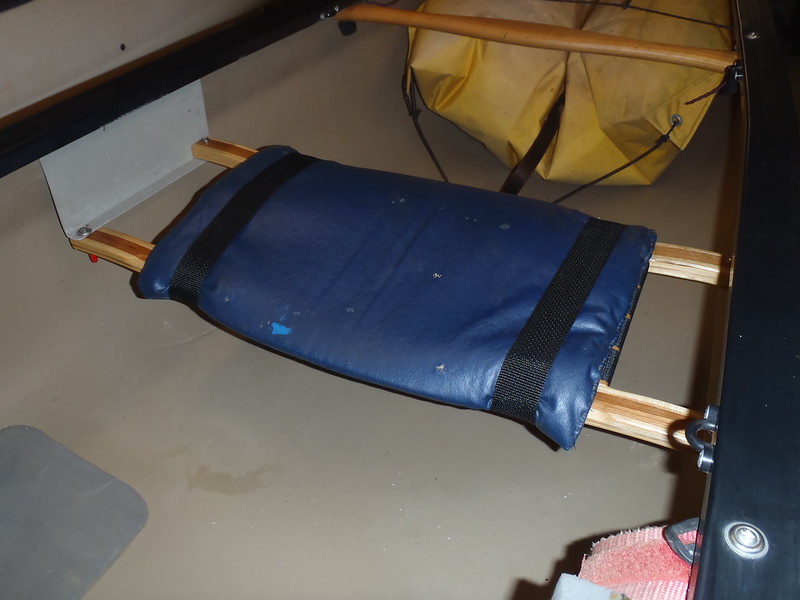G
Guest
Guest
I pulled every open canoe of the racks and inspected the seats. Unsurprisingly nearly every canoe already has some form of “custom” seat, a wide framed webbed or contour Ed’s seat. I am not replacing those, but I found two canoes with either OEM or Ed’s flat wood frame bench seats.
The 2004 Mohawk Odyssey still sports the OEM flat bench seat, and the center-to-center hole/hanger spacing is perfect for the laminated double contour seat Conk provided. My sweet spot seat-depth on the Odyssey had the seat positioned below the aluminum plate hangers, but long ago hung flat, not canted.
With a 1”deflection double contour I can now reposition the seat, front rail below the hangers, back rail atop, for ¾” of forward cant angle and maintain my sweet spot depth, with some cant angle to work in seated position with the foot brace.
 PA120011 by Mike McCrea, on Flickr
PA120011 by Mike McCrea, on Flickr
The big-boy soloized MRC Explorer has a slightly wider center-to-center machine screw and drop spacing, and Conk, bless his foresigntedness, sent me a seat that fit that spacing. The soloized Explored is big-boy canoe and seems like the place for a fat derriere back extension seat. (OK, I know that was not the design intention for that seat, but the soloized Explorer is a big boy fat-arse canoe)
 PA120012 by Mike McCrea, on Flickr
PA120012 by Mike McCrea, on Flickr
That is, I suspect, a, economical standard webbed width Ed’s Canoe Seat, short framed sideways, installed when I first rebuilt the Explorer 20 years ago. Not a super sized seat, but it was hung for super-sized paddlers, with beefy DIY truss hangers and ¼” machine screws.
Taking out the DIY truss hangers showed that the multiple coats of varnish on the butt ends had held up well, no visible decay despite some years of grunge deposit. Since I need to varnish the cut ends of both new Conk seats and inside the newly drilled holes I can sand some old varnish and recoat the truss hangers.
I like the wider frames, 20” wide instead of 13” on both seats. Anyone sitting on a 13” wide chair? Grab your tape measure and check. No? Well, there’s that to look forward to.
The usual pay attention details; drops marked for left/right and forward orientations to make reinstallation less confusing, all of the hardware stored in a little plastic pipette tip box, so I don’t lose any parts or pieces.
 PA180015 by Mike McCrea, on Flickr
PA180015 by Mike McCrea, on Flickr
WOW, picking up the old and new Explorer seats to drill new holes was a revelation. The old narrow framed seat seemed heavy in hand. It weighs 2lbs 12oz. The new wide-frame Conk seat weighs 1lb 11oz. Hot dang, the Vermont-era thick RX Explorer actually gets lighter. One canned beer’s worth, but I’ll take it.
Serendipity, that seat, as received, was nearly a perfect fit widthwise, needing just a 1/8” angle sanded off at the stern to accommodate the sheerline taper.
 PA180016 by Mike McCrea, on Flickr
PA180016 by Mike McCrea, on Flickr
Holes drilled 1/64” wider than hardware, to allow for several coats of pipe cleaner applied varnish inside the holes, and that seat is ready for some sealant.
(BTW, thanks for a needed kick in the butt Conk. I am Scots frugal when it comes to sandpaper and sanding belts. The 1x42 80 grit and 1x30 120 grit belts in the little tabletop sanders were worn baby butt smooth. A couple seconds of getting nowhere sanding those end angles was enough; I finally put on new belts. What a freaking difference)
 PA180018 by Mike McCrea, on Flickr
PA180018 by Mike McCrea, on Flickr
The double-contoured seat for the Mohawk Odyssey was as-received a couple inches wider that needed. Easy cut, drill and end sanded. I believe that the smoother those open grain ends are sanded the less likely they are to attract and hold rot causing dirt, even with multiple coats of sealant.
Cool beans, I now have attractive 3” and 2 ½” laminated ash and butternut drops should I choose to use them as drops on a future rebuild. Not that I would use that style drop, but I have them.
 PA180020 by Mike McCrea, on Flickr
PA180020 by Mike McCrea, on Flickr
The OEM Mohawk seat weighs 2lbs 3oz. Cut to length the new, wider double contour Conk seat weighs 1lb 7oz. Yeah buddy.
I knew Conk’s seats were elegant and craftsman made. I never knew they were that much lighter. Seriously, if I am rebuilding or soloizing a UL hull (I’m not, yet) it makes no sense to use a heavy bench seat.
With the seats cut, drilled and test fitted I lightly sanded down the old truss drops from the Explorer. Given the rebuild age of that soloized canoe I suspect I used real marine spar varnish. Curious side note; it was the backside of those truss drops, the non-UV exposed side, that had gone the flakiest fugliest.
The open grain butt ends are fine, but some of the varnish on the backside was actually peeling. WTF?
The open-grain tops and bottoms of those truss drops got grunge-debriding sanded. Multiple coats of Minwax Helmsman Spar Urethane this go round. I have plenty of socially distanced drying time to spend on these new seat installations.
 PA190022 by Mike McCrea, on Flickr
PA190022 by Mike McCrea, on Flickr
Five-six coats of spar urethane oughta hold it for another dozen years. It is a lot easier to spend an extra day or two now than to take it all apart in 5 years and refinish.
The 2004 Mohawk Odyssey still sports the OEM flat bench seat, and the center-to-center hole/hanger spacing is perfect for the laminated double contour seat Conk provided. My sweet spot seat-depth on the Odyssey had the seat positioned below the aluminum plate hangers, but long ago hung flat, not canted.
With a 1”deflection double contour I can now reposition the seat, front rail below the hangers, back rail atop, for ¾” of forward cant angle and maintain my sweet spot depth, with some cant angle to work in seated position with the foot brace.
 PA120011 by Mike McCrea, on Flickr
PA120011 by Mike McCrea, on FlickrThe big-boy soloized MRC Explorer has a slightly wider center-to-center machine screw and drop spacing, and Conk, bless his foresigntedness, sent me a seat that fit that spacing. The soloized Explored is big-boy canoe and seems like the place for a fat derriere back extension seat. (OK, I know that was not the design intention for that seat, but the soloized Explorer is a big boy fat-arse canoe)
 PA120012 by Mike McCrea, on Flickr
PA120012 by Mike McCrea, on FlickrThat is, I suspect, a, economical standard webbed width Ed’s Canoe Seat, short framed sideways, installed when I first rebuilt the Explorer 20 years ago. Not a super sized seat, but it was hung for super-sized paddlers, with beefy DIY truss hangers and ¼” machine screws.
Taking out the DIY truss hangers showed that the multiple coats of varnish on the butt ends had held up well, no visible decay despite some years of grunge deposit. Since I need to varnish the cut ends of both new Conk seats and inside the newly drilled holes I can sand some old varnish and recoat the truss hangers.
I like the wider frames, 20” wide instead of 13” on both seats. Anyone sitting on a 13” wide chair? Grab your tape measure and check. No? Well, there’s that to look forward to.
The usual pay attention details; drops marked for left/right and forward orientations to make reinstallation less confusing, all of the hardware stored in a little plastic pipette tip box, so I don’t lose any parts or pieces.
 PA180015 by Mike McCrea, on Flickr
PA180015 by Mike McCrea, on FlickrWOW, picking up the old and new Explorer seats to drill new holes was a revelation. The old narrow framed seat seemed heavy in hand. It weighs 2lbs 12oz. The new wide-frame Conk seat weighs 1lb 11oz. Hot dang, the Vermont-era thick RX Explorer actually gets lighter. One canned beer’s worth, but I’ll take it.
Serendipity, that seat, as received, was nearly a perfect fit widthwise, needing just a 1/8” angle sanded off at the stern to accommodate the sheerline taper.
 PA180016 by Mike McCrea, on Flickr
PA180016 by Mike McCrea, on FlickrHoles drilled 1/64” wider than hardware, to allow for several coats of pipe cleaner applied varnish inside the holes, and that seat is ready for some sealant.
(BTW, thanks for a needed kick in the butt Conk. I am Scots frugal when it comes to sandpaper and sanding belts. The 1x42 80 grit and 1x30 120 grit belts in the little tabletop sanders were worn baby butt smooth. A couple seconds of getting nowhere sanding those end angles was enough; I finally put on new belts. What a freaking difference)
 PA180018 by Mike McCrea, on Flickr
PA180018 by Mike McCrea, on FlickrThe double-contoured seat for the Mohawk Odyssey was as-received a couple inches wider that needed. Easy cut, drill and end sanded. I believe that the smoother those open grain ends are sanded the less likely they are to attract and hold rot causing dirt, even with multiple coats of sealant.
Cool beans, I now have attractive 3” and 2 ½” laminated ash and butternut drops should I choose to use them as drops on a future rebuild. Not that I would use that style drop, but I have them.
 PA180020 by Mike McCrea, on Flickr
PA180020 by Mike McCrea, on FlickrThe OEM Mohawk seat weighs 2lbs 3oz. Cut to length the new, wider double contour Conk seat weighs 1lb 7oz. Yeah buddy.
I knew Conk’s seats were elegant and craftsman made. I never knew they were that much lighter. Seriously, if I am rebuilding or soloizing a UL hull (I’m not, yet) it makes no sense to use a heavy bench seat.
With the seats cut, drilled and test fitted I lightly sanded down the old truss drops from the Explorer. Given the rebuild age of that soloized canoe I suspect I used real marine spar varnish. Curious side note; it was the backside of those truss drops, the non-UV exposed side, that had gone the flakiest fugliest.
The open grain butt ends are fine, but some of the varnish on the backside was actually peeling. WTF?
The open-grain tops and bottoms of those truss drops got grunge-debriding sanded. Multiple coats of Minwax Helmsman Spar Urethane this go round. I have plenty of socially distanced drying time to spend on these new seat installations.
 PA190022 by Mike McCrea, on Flickr
PA190022 by Mike McCrea, on FlickrFive-six coats of spar urethane oughta hold it for another dozen years. It is a lot easier to spend an extra day or two now than to take it all apart in 5 years and refinish.









